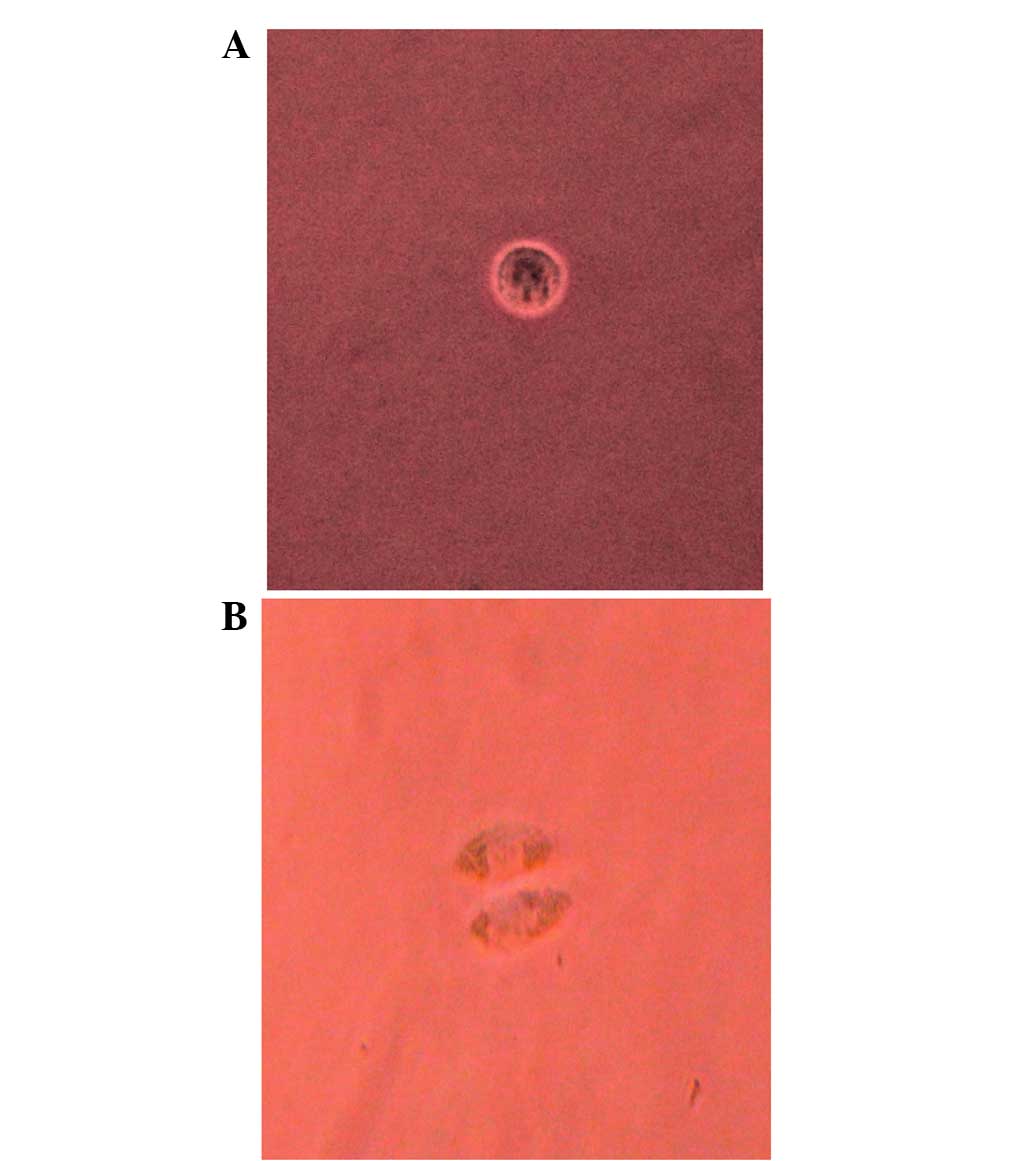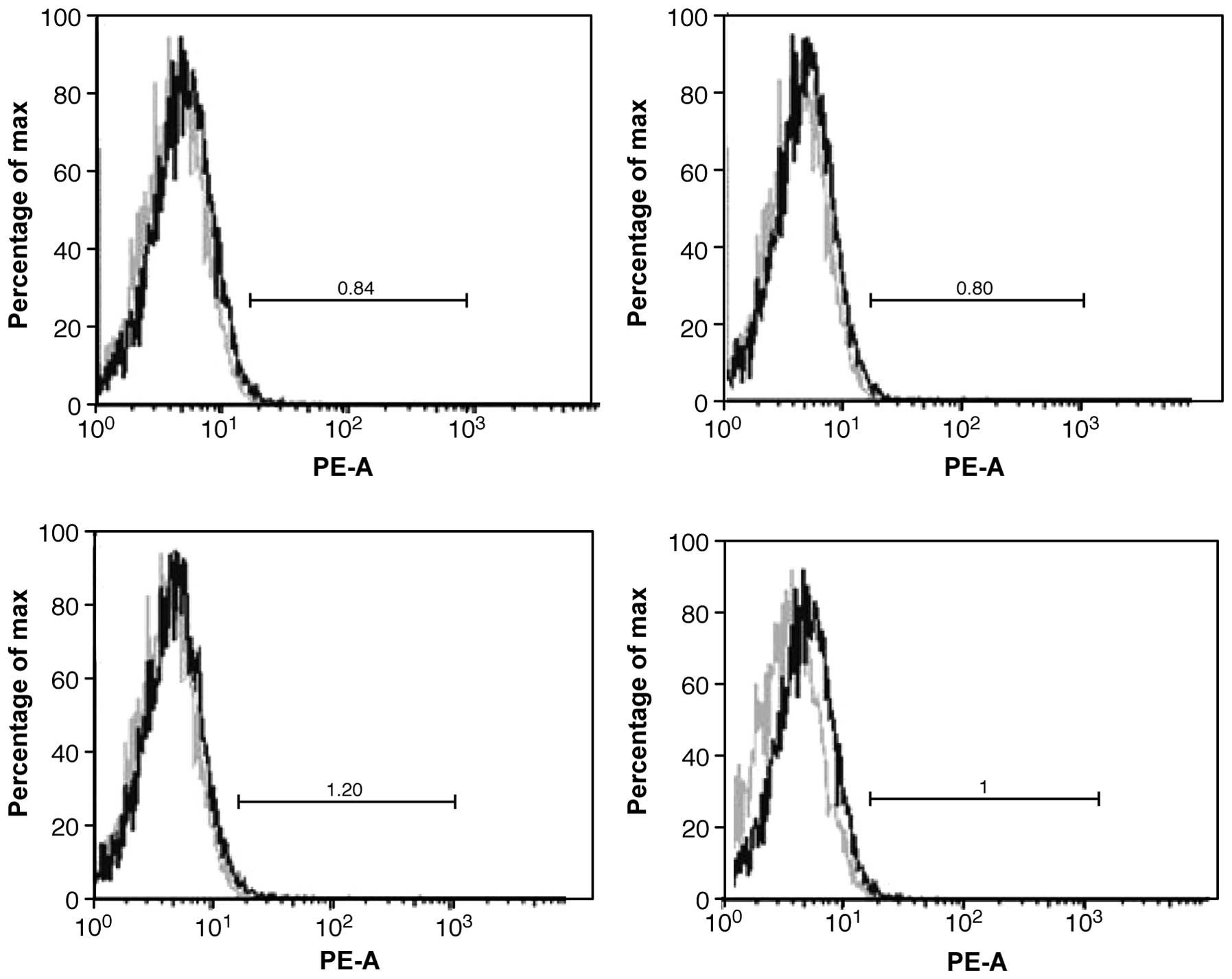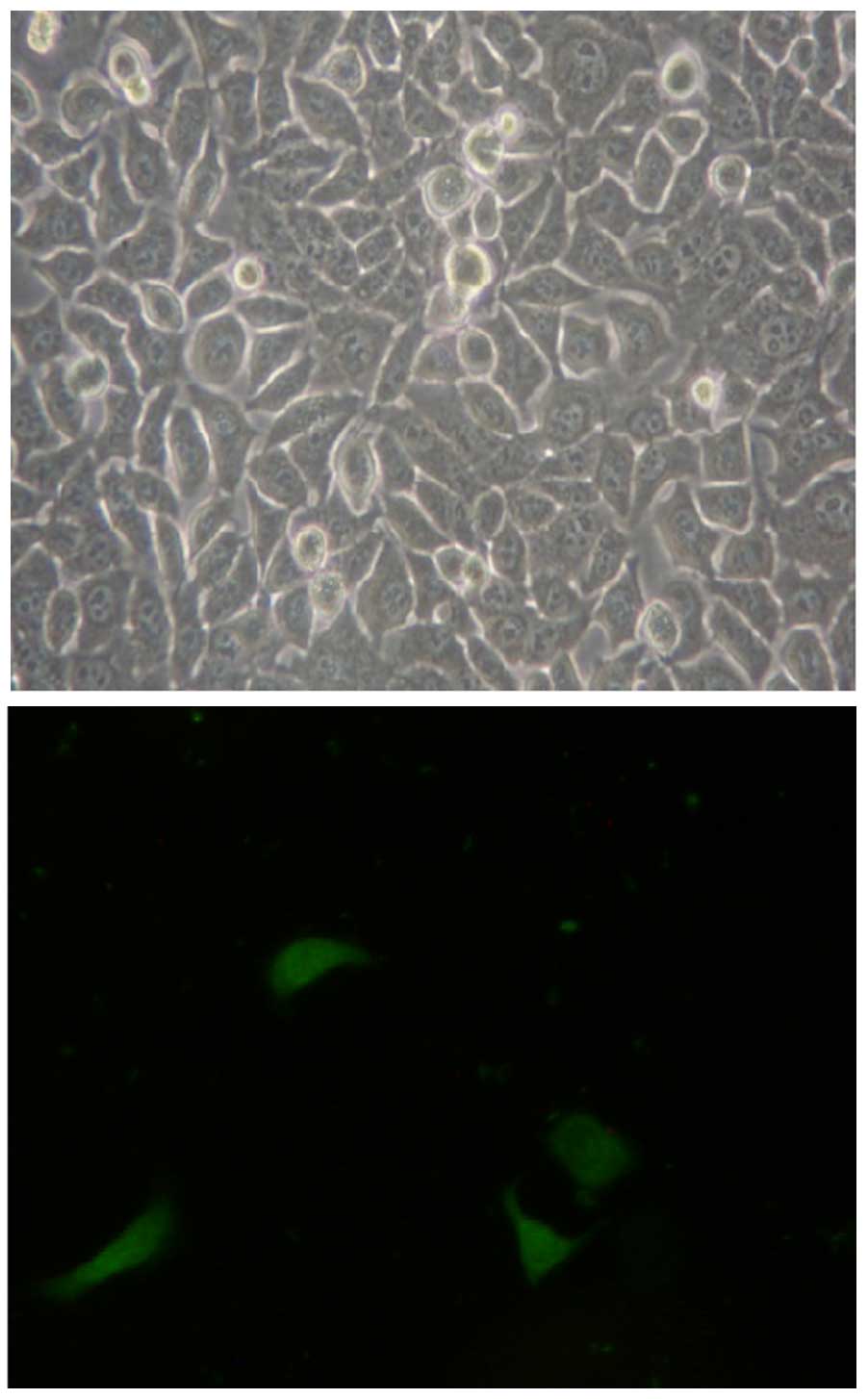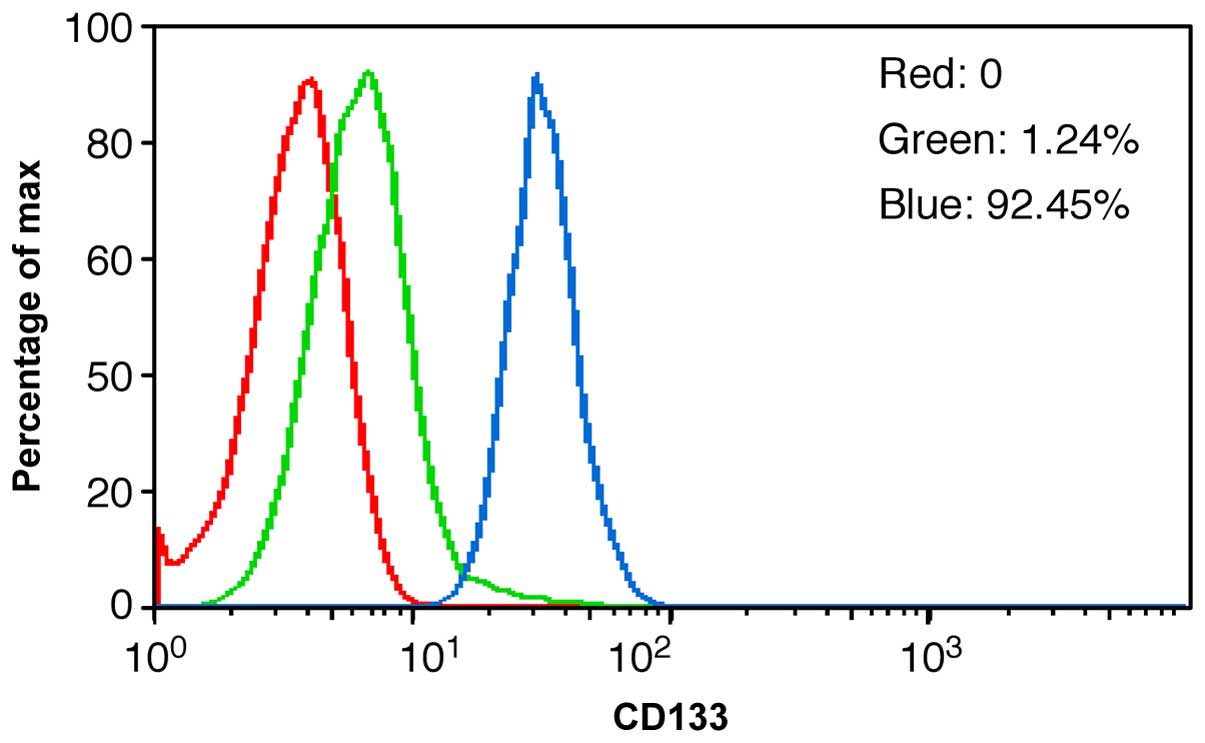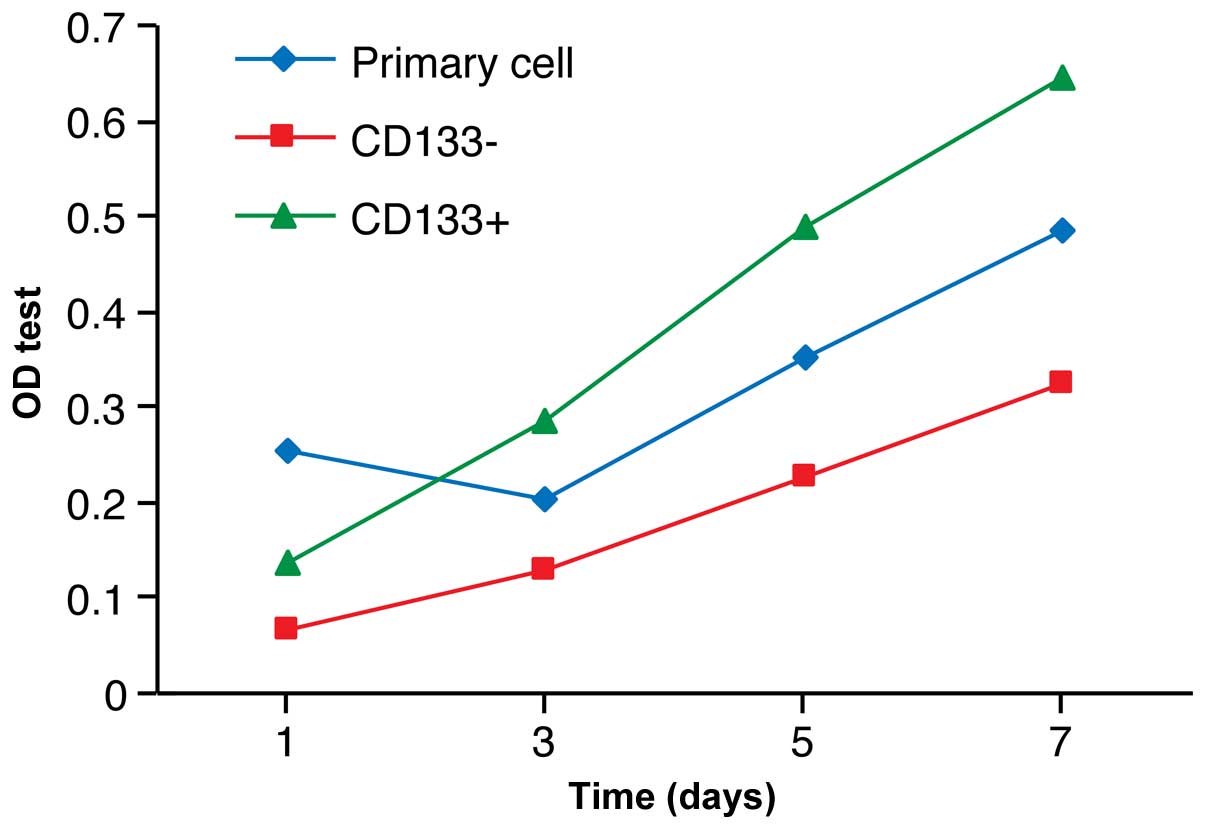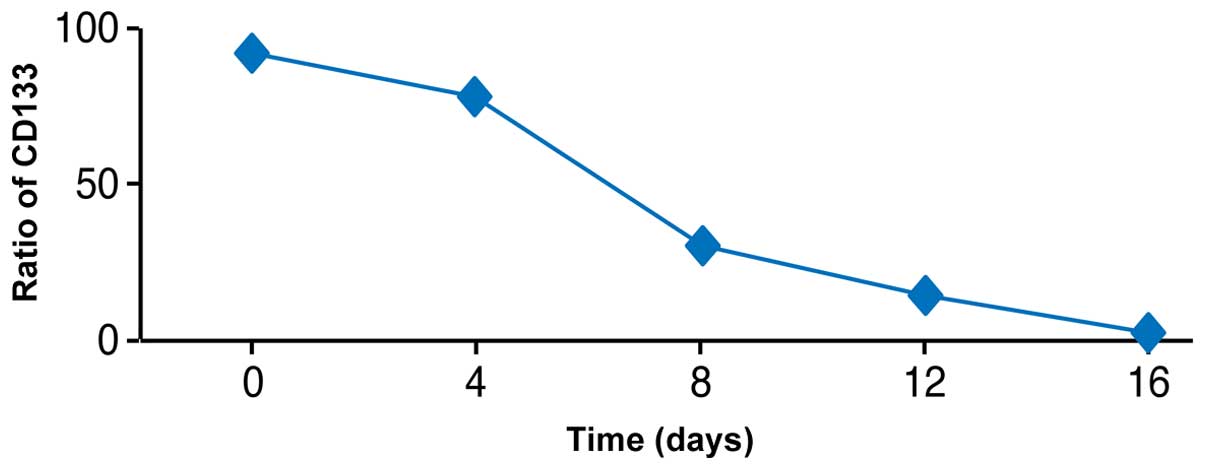Role of CD133+ cells in tongue squamous carcinomas: Characteristics of ‘stemness’ in vivo and in vitro
- Authors:
- Published online on: June 15, 2016 https://doi.org/10.3892/ol.2016.4719
- Pages: 863-870
-
Copyright: © Wang et al. This is an open access article distributed under the terms of Creative Commons Attribution License.
Abstract
Introduction
Despite increasingly successful initial therapies for various cancers, recurrent secondary tumours remain a problem (1). Malignant tumour cells are heterogeneous; only a small proportion of cells in solid tumour cancer stem cells are reportedly able to form colonies in clonogenic assays in vitro (2). Cancer stem cells have been identified in numerous types of malignancies (3–5). As a result, increasing attention has been focused on cancer stem cells in oncological research. However, there have been few reports on oral and maxillofacial malignant tumours.
Cluster of differentiation 133 (CD133; formerly known as AC133) is a highly-conserved antigen that is the human homologue of mouse Prominin-1, which was initially identified as a 5-transmembrane cell surface glycoprotein, and was classified as a marker for primitive haematopoietic and neural stem cells. CD133 is also considered a universal marker of organ-specific stem cells and tumour-initiating cells. CD133 protein plays an important role in supporting tumour growth (6,7). In addition, CD133+ cells are involved in tumourigenesis, invasion, metastasis, drug resistance and disease relapse (8). CD133 is detectable in a range of solid tumours, but there has been little research on its role in oral and maxillofacial tumours. Based on a previous study on the characterisation of cancer stem cells, CD133 has been identified as a common marker for cancer stem cells (9). It is therefore reasonable to suspect that the CD133 antigen is a marker for cancer stem cells associated with tongue squamous carcinoma. The purpose of the present study was to determine whether CD133 is a surface marker of tongue squamous carcinoma stem cells. In this study, immunomagnetic beads were used to select and purify CD133+ tumour cells, which were then cultured. The proliferative ability of these cells was observed in vitro.
Materials and methods
Cell preparation
The Tca-8113 cell line was obtained from the Ninth Affiliated People's Hospital, Shanghai Jiao Tong University (Shanghai, China) and stored in liquid nitrogen.
Single cell culture in vitro
The Tca-8113 cells (2×105) were thawed and cultured in RPMI-1640 medium supplemented with 10% foetal calf serum (FCS; Hangzhou Sijiqing Biological Engineering Materials Co., Ltd., Hanzhou, China) in 100% relative humidity at 37°C in an atmosphere containing 5% CO2. Cells in the exponential growth phase were collected after trypsin-ethylenediamine tetra-acetic acid digestion and washed twice in phosphate-buffered saline (PBS). The cell pellets were then suspended in PBS, and the cells were counted. Using the limited dilution method, the cell concentration was changed to 10–15/ml, and the cell suspension with uniform distribution was then transferred (1 cell/100 µl) to single wells using a pipette. The wells in which single cells were successfully isolated (verified by inverted phase contrast microscopy) were marked. The cells were transferred in this manner for a total of 384 wells (4 plates). The culture was repeated three times at the same time in vitro. Changes in population and cell morphology were observed using an inverted microscope.
Sphere formation
To test their ability for growth and sphere formation in suspension, the cells were trypsinized and passed through a 40-µm filter to obtain a single cell suspension. In total, 10 ml of media containing 2×104 cells was added to 96-well ultra-low attachment plates (Corning Inc., Corning, NY, USA). After 7 days, the plates were visually assayed for the formation of floating spheres. To assess the ability of primary spheres to form secondary spheres, the primary spheres were collected by centrifugation (1,000 × g for 5 min) and again digested to single-cell suspensions, and passed through a 40-µm filter. A total of 10 ml of medium containing 2×104 cells was added to 96-well ultra-low attachment plates (Corning Inc.). To determine the viability and self-renewal abilities of the constituent cells, after 7 days, secondary spheres were collected and placed into adherent plates to assess their colony-formation patterns.
Flow cytometry (FCM)
The Tca-8113 cells were digested with 0.25% trypsin, and the digestion was terminated with culture media. The cells were washed twice in 0.01% PBS and suspended by centrifugation (centrifuge radius, 132 mm; 1,000 rpm; 5 min). Phycoerythrin (PE)-conjugated CD133 antibody (20 µl; 1:20 dilution; catalog no. 130080801; eBioscience, San Diego, CA, USA) was added to the fluid. The cells were then incubated for 1 h at room temperature in the dark. The isotype control was immunoglobulin (Ig)G-PE (eBioscience). The cells were rewashed in 0.01% PBS and detected using FCM (FACStarplus; BD Biosciences, Franklin Lakes, NJ, USA). The PE conjugate was excited with an argon laser at 488 nm and was collected at 575/26 nm.
Immunocytochemistry
The adherent Tca-8113 cells were digested with 0.25% trypsin, transferred to cover slips and placed in culture dishes with small amounts of RPMI 1640 culture medium (Gibco; Thermo Fisher Scientific, Inc., Rockville, MD, USA). Further medium was added to the culture dishes after the cells had adhered to the cover slips. The cells were then cultivated for 48–72 h. The cells were fixed for 5 min in acetone and washed in 0.01% PBS. Next, 30 µl fluorescein isothiocyanate (FITC)-labelled anti-CD133 antibody (catalog no. 46133182; R&D Systems Inc., Minneapolis, MN, USA) was added to cover the cells, which were incubated for 1 h at room temperature in the dark. The cells were then washed with 0.01% PBS, mounted in anhydrous glycerol and observed using a fluorescence microscope.
Magnetic sorting of CD133+ cells and in vitro culture
The Tca-8113 cells were conventionally cultured with 10% FCS. The cells in the exponential growth phase were digested (with 0.25% trypsin) and counted. The cell density was reduced to 3–5×107 cells/ml. The Tca-8113 cells (1×108 cells/0.3 ml) were completely suspended in incubation fluid (PBE) consisting of 0.5% NBS, 2 mm EDTA (pH 7.2) and PBS. FC receptor-blocking pharmacon (100 µl; Miltenyi Biotec Inc., Bergisch Gladbach, Germany) was added to the cells, which were incubated for 30 min at 4°C. Next, 0.1 ml of CD133 antibody-conjugated magnetic beads (catalog no. 130-091-895; Miltenyi Biotec, Inc.) was added to the cells for 30 min at 4°C. The final volume was 0.5 ml. The cells were washed in 1 ml PBE, centrifuged (940 × g for 10 min) and suspended completely in 0.5 ml PBE. The CD133+ cells were labelled with primary CD133/1 antibody (mouse IgG1, 111 per million cells; Miltenyi Biotec Inc.), magnetically labelled with rat anti-mouse IgG1 microbeads (Miltenyi Biotec Inc.; 2,011 per 10 million cells), and separated on a magnetic-activated cell sorting (MACS) LS column (Miltenyi Biotec Inc.). All the procedures were performed according to the manufacturer's instructions.
In vitro CD133+ cell reproductive test
CD133+, CD133– and primary cells were respectively separated using MACS. After these cells were prepared as single-cell suspensions, they were transferred to 96-well microwell plates with 1–2×103 cells/well. Samples from each group were placed into 3 wells, and 0.2 ml RPMI 1640 complete culture solution was placed in each well. The cells were cultured in 100% relative humidity at 37°C in an atmosphere containing 5% CO2. Cell proliferation was examined on days 1, 3, 5 and 7. The viable count was quantified by an optical density (OD) at 450 nm absorbance and with Cell Counting kit-8 (CCK-8; Beyotime Institute of Biotechnology, Haimen, China). Finally, to compare the growth rates of the 3 cell groups, a cell growth curve was drawn according to the association between the date and absorbance.
CD133+ cell differentiation potency test in vitro
Single CD133+ cells were cultured in RPMI 1640 complete culture solution with 10% foetal bovine serum, in 100% relative humidity at 37°C, in an atmosphere containing 5% CO2. The culture fluid was changed once every 2 days. The percentage of cells expressing CD133+ was evaluated on days 0, 4, 8, 12 and 16 using FCM.
Tumourigenic capacity of CD133+ cells in NOD/SCID mice
A total of 90 NOD/SCID male mice, classified into 3 groups and weighing 40–50g, were purchased form the Animal Breeding Center of The Second Military Medical University of Chinese People's Liberation Army (Shanghai, China). Mice were maintained at the animal room (specific pathogen-free) of Tongji Stomatology School (Shanghai, China), at 20°C with 50% humidity. All experiments were approved by the Ethics Committee of Tongji Stomatology School.
CD133+ and CD133– cells obtained by MACS from the Tca-8113 cell line and unsorted cells were subcutaneously inoculated into the left and right axillas, and the backs of NOD/SCID mice, respectively, with 1×105 cells/ml in 3 injection points per mouse. The tumourigenic capacity and different phenotypes of tumour cells from the Tca-8113 cell line in the NOD/SCID mice were observed every 2 days after inoculation for a total of 8 weeks. The mice were sacrificed by an overdose of anesthesia drugs injected into the vein.
Statistical analysis
All data are presented as the mean ± standard error. Results were analysed using analysis of variance or t-test with SPSS version 14.0 software (SPSS, Inc., Chicago, IL, USA). P<0.05 was considered to indicate a statistically significant difference.
Results
Single-cell culture in vitro
At first, the Tca-8113 cells seeded into the 96-well microwell plates were round and exhibited halation and translucent circumferentia. After 12 h, certain cells adhered to the substrates and other cells demonstrated vacuoles in their centres or were fragmented and dead. After 24 h, almost all the cells were adhered to the substrates and had begun to differentiate; these cells were polygonal with abundant cytoplasm and displayed polynuclear anachromasis. After 8 days, only 10.85% of the cells demonstrated a stronger proliferative capability; this was true of 5.23 and 5.09% of the cells by days 12 and 16, respectively (Table I; Figs. 1 and 2).
Sphere formation in suspension
The Tca-8113 cells were observed forming floating clusters of cells within 7 days of plating into non-adherent plates. Primary sphere formation by these cells is illustrated in Fig. 3. When the primary spheres were dissociated and re-plated, spheres from all three groups demonstrated an ability to form secondary spheres and an increase in the total number of spheres. When cells forming secondary spheres were dissociated and placed into standard tissue culture plates, they adhered and formed colonies with primarily holoclone morphologies (Fig. 3).
CD133 expression by FCM
Relatively few tumour cells expressed CD133. Approximately 0.95% of the cells were highly expressed on the cell membrane (Fig. 4).
CD133 expression illustrated by immunocytochemical staining
As observed under fluorescence microscopy, CD133 cells were labelled with an FITC-CD133 antibody; its green fluorescence appeared to have a scattered distribution, which indicated that CD133 was distributed on the cell membranes. Only a low percentage of whole-tongue squamous Tca8113 carcinoma cells expressed CD133 (Fig. 5).
CD133+ cells purified by MACS
Sustainable separate tumour cells were highly purified; 92.45% of the separated cells expressed CD133. MACS appeared to be a better method than FCM for identifying CD133+ expression, as it was less damaging to the cells and better retained their proliferative ability (Fig. 6).
Proliferation activity of CD133+ cells in vitro
The CD133+ cells grew quickly between days 3 and 5, while the CD133– cells grew much more slowly, indicating less proliferative activity (Fig. 7).
Differentiation potency of CD133+ cells in vitro
The proportion of CD133+ cells decreased in culture over time. During 16 days of culture, the percentage of CD133+ cells decreased from 92.45 to 1.62% (similar to CD133 expression ratios in sustainable separate cells) (Fig. 8).
Tumourigenic capacity of CD133+ cells in NOD/SCID mice
The NOD/SCID mice were sacrificed according to the national animal care laws. The subcutaneous tumours were exposed after the NOD/SCID mice were sacrificed. The tumours generated from the CD133+ cells were markedly larger compared with the tumours generated from the CD133– cells. In addition, in terms of the tumourigenic time, the CD133+ cells could generate tumours in ~1 week, whereas CD133– cells required 10 to 14 days or longer (Fig. 9).
Haematoxylin and eosin (HE) staining in tongue squamous carcinoma tissues
The histopathological HE staining demonstrated that a large number of oblate and pleomorphic cells were present in the tissues, with an abundant and eosinophilic cytoplasm. The nuclei (blue) were large, with substantial atypia. The nucleocytoplasmic ratio was high, with clear nucleoli and multiple mitotic phases, and the presence of cancer nests was observed, indicating that the tissues generated from the CD133 cells and unsorted cells transplanted into the NOD/SCID mice were cancerous (Fig. 10).
Number of CD133 cells in NOD/SCID mice
The tumourigenic rate of CD133+ cells was markedly higher than that of the CD133– cells, which reached almost 50%. Thus, CD133– cells also exhibit a strong tumourigenic ability with a certain degree of stemness (Table II).
Discussion
Although research regarding cancer stem cells could open a wide range of clinical possibilities, identifying these cells has been difficult. Certain data indicate that tumour stem cells in a number of cancers are derived from adult stem cells (e.g., haematological neoplasms, breast cancer and human brain glioma) (10,11). These cells are the foundation of tumourigenesis, but only account for a small portion of tumour cells. Bonnet and Dick (12) found and confirmed the existence of tumour stem cells initially by isolating CD34+/CD38– stem cells in acute myeloblastic leukaemia cells. Al-Hajj et al (3) first verified the existence of tumour stem cells in solid tumours by identifying tumour stem cells with the characteristic marker Lin–ESA+/CD44+/CD24–/low in a breast carcinoma NOD/SCID mouse model. Recently, Singh et al (4) identified CD133+ as a cell-surface marker in brain tumours. A study by Jordan (13) also demonstrated the oncogenicity of CD133+ cells, which further supports the hypothesis of tumour stem cells.
In the present study, the isolation and characterisation of a highly tumourigenic subpopulation of cells were described in human tongue squamous carcinoma. We believe that this is the first description of the isolation of malignant progenitors from human tongue squamous carcinoma. Over the past several years, CD133 has been identified as a cancer stem cell marker, including stem cells for cancer of adult brain, prostatic carcinoma, colon carcinoma and liver cancer (5,14–17). Five separate criteria have been established for cancer stem cells: i) The cells can self-renew; ii) they are part of a small minority of the total tumour cell population; iii) they present a reproducible tumour phenotype; iv) they are capable of multipotent differentiation into non-tumourigenic cells; and v) they carry distinct cell surface antigenic phenotypes, permitting consistent isolation (18,19). CD133+ cancer stem cells are capable of unlimited self-renewal (20). Therefore, we hypothesized that cancer stem cells may exist in tongue squamous carcinoma. Further investigations will be performed to determine whether the CD133 antigen is a surface marker of tumour stem cells, and to assess the biological activity and proliferation state of CD133+ cells in the human tongue squamous carcinoma Tca8113 cell line.
Malignant tumours are capable of unlimited self-renewal and heterogeneity (21). In the present study, monoclonal tongue squamous carcinoma cells were cultured in vitro after being monoclonally cultured in vitro; the proliferation ratio was similar to that of primary tumour cells, which indicated that only a small percentage of tumour cells possessed clone capacity, heterogeneity and the characteristics of tumour stem cells in vitro. Fluorescence immunocytology demonstrated the distribution of CD133+ cells in the Tca8113 cell line. Green fluorescence was distributed discretely among the cells; only 0.95% of the Tca8113 cells expressed the CD133 antigen, indicating that a low proportion of tongue squamous carcinoma cells were CD133+.
Studies have demonstrated that normal stem cells and malignant tumour stem cells can be derived from nervous system tissue (the growth of which has been suspended) (22). Subsequently, this phenomenon was also observed in normal breast tissue and malignant breast cancer, allowing cancer stem cells to be isolated from malignant breast cancer. Further studies indicated that suspended growth was a characteristic of cancer stem cells (23). Current research regarding head and neck malignant cell lines has found that suspended cells (and the secondary cultures of these cells) in the tongue Tca-8113 cell lines are also able to form ‘tumour spheres’ (24). After re-plating the ‘tumour spheres’ to adhesive culture plates, the present study found that these cells retained a strong capacity for self-renewal and proliferation, indicating that the tongue squamous cell carcinoma Tca-8113 cell line has its own cancer stem cells.
Cell Counting kit-8 is a novel method of measuring cell viability. The principle is coincidental with the MTT method. CCK-8 may form a hydrosoluble yellow formazan dye. This method is convenient, and the variation in the results is low. Moreover, compared with MTT, the OD and linear correlation are better and offer a more sensitive and reproducible assay. The present study found that the CD133+ tumour cells had a significantly higher rate of proliferation than the CD133– tumour cells and the primary cells. Among these three cell types, the proliferation rate of CD133– cells was the slowest and that of CD133+ cells was the strongest.
MACS involves combining magnetic beads with mono-antibodies to a cell-surface antigen. The cells displaying the antigen are adsorbed to the magnetic beads and held in a magnetic field. In the present study, MACS was utilised to isolate positive and negative cells from the primary tumour cells. MACS offered a stable and repeatable methodology, separated the majority of the cells of interest (purity of separation >90%) and only slightly affected the energy state of the cells (25). Moreover, post-separation contamination and cell damage were reduced.
The cell growth of the CD133+ cells was faster than that of the CD133– or unsorted tumour cells. The proportion of CD133+ cells decreased in culture over time (decreasing from 92.45% initially to 1.62% at day 12), indicating that the CD133+ cells differentiated over time. This phenomenon is consistent with stem cell bionomics. The percentage of tumour stem cells was extremely low (0.01–5%), but the percentage of persistent tumour cells was >5%. The Tca-8113 cell lines in certain studies (26) have been found to establish a tumour phenotype. Researcher bias may also be an issue.
The establishment of animal models provides an ideal testing tool for basic theory studies on the biological behaviour and regulation of metastasis of malignant tumours and tumourigenic mechanisms. By analysing the CD133 cells transplanted into NOD/SCID mice, Singh et al (4) found that 100 CD133+ cells could lead to tumourigenesis in NOD/SCID mice. However, transplantation of 50,000–100,000 CD133– cells did not lead to tumourigenesis. A study by Jordan (13) further confirmed the tumourigenesis of CD133+ cells. O'Brien et al (5) used tumours from patients with colon cancer to inject CD133 antibodies into NOD/SCD mice, and the result demonstrated that CD133+ had a strong tumourigenic ability. The CD133+ tumour cells in the NOD/SCID mice were again transplanted into new NOD/SCID mice, and the result demonstrated that the newly formed tumours had a similar phenotypic heterogeneity as the original tumours.
The present study also used NOD/SCID mice. Suspensions of CD133+, CD133– and unsorted cells (5×105/-2.5×108/ml) from the tongue squamous cell line were subcutaneously injected into the mice using a syringe (after disinfection). After 2 months, the subcutaneous tumours were exposed following sacrifice of the NOD/SCID mice, and the tumours generated from the CD133+ cells were significantly larger than those generated from the CD133– cells. Regarding tumourigenesis time, the CD133+ cells required ~1 week and the CD133– cells required 10 to 14 days, or even longer. However, the CD133– cells also demonstrated a tumourigenic capacity.
The present study was based on the observation that the Tca-8113 cell line is heterogeneous and could include cancer stem cells. Such cells could exist in suspended growth, but be able to form ‘tumour spheres’. The proportion of CD133+ cells to other tumour cells was only 0.95%; moreover, the CD133+ cells were capable of unlimited self-renewal and proliferation. In brief, we consider CD133 to be a phenotype of tumour stem cells (possibly in combination with other markers). This conclusion will require further research. However, identification of the function of CD133 may increase our understanding of its role in tumourigenesis.
According to the literature, there are some stem cells in CD133– populations (27). The present study also found that CD133– cells possess reproductive activity to a certain extent, suggesting that tumour stem cells may be present in this subpopulation. Nevertheless, it is worthwhile to investigate whether CD133 is a specific marker in tongue squamous carcinoma. Research in this area may elucidate the mechanism of tumourigenesis and provide an original premise for developing antitumour drugs in the future (28).
In conclusion, it is possible that CD133 may be a phenotypic marker of tumour stem cells in the Tca-8113 cell line of tongue squamous cancer. The surface markers of tumour stem cells of tongue squamous cancer may be a combination of various cell phenotypes. If this is the case, CD133 can be used to purify stem cells and identify surface markers of the Tca-8113 cell line in order to study protein expression and signal transduction. Furthermore, CD133 can be used as a therapy target for the radical treatment of tumours.
Acknowledgements
The authors would like to thank the Ninth Affiliated People's Hospital of Shanghai Jiao Tong University for the Tca-8113 cell line, and the animal room of Tongji University School of Stomatology for assistance with the animal experiments. This study was supported by the National Natural Science Foundation of China (grant no. 30700956) and the Shanghai City Natural Science Foundation (grant no. 06ZR14084).
References
|
Choi IK and Yun CO: Recent developments in oncolytic adenovirus-based immunotherapeutic agents for use against metastatic cancers. Cancer Gene Ther. 20:70–76. 2013. View Article : Google Scholar : PubMed/NCBI | |
|
Heppner GH and Miller BE: Tumor heterogeneity: biological implications and therapeutic consequences. Cancer metastasis Rev. 2:5–23. 1983. View Article : Google Scholar : PubMed/NCBI | |
|
Al-Hajj M, Wicha MS, Benito-Hernandez A, Morrison SJ and Clarke MF: Prospective identification of tumorigenic breast cancer cells. Proc Natl Acad Sci USA. 100:3983–3988. 2003. View Article : Google Scholar : PubMed/NCBI | |
|
Singh SK, Clarke ID, Terasaki M, Bonn VE, Hawkins C, Squire J and Dirks PB: Identification of a cancer stem cell in human brain tumors. Cancer Res. 63:582l–5828. 2003. | |
|
O'Brien CA, Pollett A, Gallinger S and Dick JE: A human colon cancer cell capable of initiating tumor growth in immunodeficient mice. Nature. 445:106–110. 2007. View Article : Google Scholar : PubMed/NCBI | |
|
Hide T and Kuratsu J: Progress in the study of brain tumor stem cells as treatment target. Brain Nerve. 61:781–789. 2009.(In Japanese). PubMed/NCBI | |
|
Binello E and Germano IM: Targeting glioma stem cells: a novel framework for brain tumors. Cancer Sci. 102:1958–1966. 2011. View Article : Google Scholar : PubMed/NCBI | |
|
Liu G, Yuan X, Zeng Z, Tunici P, Ng H, Abdulkadir IR, Lu L, Irvin D, Black KL and Yu JS: Analysis of gene expression and chemoresistance of CDl33+ cancer stem cells in glioblastoma. Mol Cancer. 5:672006. View Article : Google Scholar : PubMed/NCBI | |
|
Wei XD, Zhou L, Cheng L and Tian J: Experimental investigation of CD133 as a putative marker of tumor-initiating cell in laryngeal carcinoma. Zhonghua Er Bi Yan Hou Tou Jing Wai Ke Za Zhi. 41:940–944. 2006.(In Chinese). PubMed/NCBI | |
|
Yuan X, Curtin J, Xiong Y, Liu G, Waschsmann-Hogiu S, Farkas DL, Black KL and Yu JS: Isolation of cancer stem cells from adult glioblastoma multiforme. Oncogene. 23:9392–9400. 2004. View Article : Google Scholar : PubMed/NCBI | |
|
Behbod F and Rosen JM: Will cancer stem cells provide new therapeutic targets? Carcinogenesis. 26:703–711. 2005. View Article : Google Scholar : PubMed/NCBI | |
|
Bonnet D and Dick JE: Human acute myeloid leukemia is organized as a hierarchy that originates from a primitive hematopoietic cell. Nat Med. 3:730–737. 1997. View Article : Google Scholar : PubMed/NCBI | |
|
Jordan CT: Cancer stem cell biology: From leukemia to solid tumors. Curr Opin Cell Biol. 16:708–712. 2004. View Article : Google Scholar : PubMed/NCBI | |
|
Ricci-Vitiani L, Lombardi DG, Pilozzi E, Biffoni M, Todaro M, Peschle C and De Maria R: Identification and expansion of human colon-cancer initiating cells. Nature. 445:111–115. 2007. View Article : Google Scholar : PubMed/NCBI | |
|
Collins AT, Berry PA, Hyde C, Stower MJ and Maitland NJ: Prospective identification of tumorigenic prostate cancer stem cells. Cancer Res. 65:10946–10951. 2005. View Article : Google Scholar : PubMed/NCBI | |
|
Suetsugu A, Nagaki M, Aoki H, Motohashi T, Kunisada T and Moriwaki H: Characterization of CD133+ hepatocellular carcinoma cells as cancer stem/progenitor cells. Biochem Biophys Res Commun. 351:820–824. 2006. View Article : Google Scholar : PubMed/NCBI | |
|
Ma S, Chan KW, Hu L, Lee TK, Wo JY, Ng IO, Zheng BJ and Guan XY: Identification and characterization of tumorigenic liver cancer stem/progenitor cells. Gastroenterology. 132:2542–2556. 2007. View Article : Google Scholar : PubMed/NCBI | |
|
Dalerba P, Cho RW and Clarke MF: Cancer stem cells: Models and concepts. Annu Rev Med. 58:267–284. 2007. View Article : Google Scholar : PubMed/NCBI | |
|
Clarke MF, Dick JE, Dirks PB, Eaves CJ, Jamieson CH, Jones DL, Visvader J, Weissman IL and Wahl GM: Cancer stem cells-perspectives on current status and future directions: AACR workshop on cancer stem cells. Cancer Res. 66:9339–9344. 2006. View Article : Google Scholar : PubMed/NCBI | |
|
Bar EE, Chaudhry A, Lin A, Fan X, Schreck K, Matsui W, Piccirillo S, Vescovi AL, DiMeco F, Olivi A and Eberhart CG: Cyclopamine-mediated hedgehog pathway inhibition depletes stem-like cancer cells in glioblastoma. Stem Cells. 25:2524–2533. 2007. View Article : Google Scholar : PubMed/NCBI | |
|
Rowehl RA, Burke S, Bialkowska AB, Pettet DW 3rd, Rowehl L, Li E, Antoniou E, Zhang Y, Bergamaschi R, Shroyer KR, et al: Establishment of highly tumorigenic human colorectal cancer cell line (CR4) with properties of putative cancer stem cells. PLoS One. 9:e990912014. View Article : Google Scholar : PubMed/NCBI | |
|
Dontu G, Al-Hajj M, Abdallah WM, Clarke MF and Wicha MS: Stem cells in normal breast development and breast cancer. Cell Prolif. 36(Suppl 1): S59–S72. 2003. View Article : Google Scholar | |
|
Patrawala L, Calhoun T, Schneider-Broussard R, Zhou J, Claypool K and Tang DG: Side population is enriched in tumorigenic, stem-like cancer cells, whereas ABCG2+ and ABCG2– cancer cells are similarly tumorigenic. Cancer Res. 65:6207–6219. 2005. View Article : Google Scholar : PubMed/NCBI | |
|
Harper LJ, Piper K, Common J, Fortune F and Mackenzie IC: Stem cell patterns in cell lines derived from head and neck squamous cell carcinoma. J Oral Pathol Med. 36:594–603. 2007. View Article : Google Scholar : PubMed/NCBI | |
|
Nishi H, Nishimura S, Higashiura M, Ikeya N, Ohta H, Tsuji T, Nishimura M, Ohnishi S and Higashi H: A new method for histamine release from purified peripheral blood basophils using monoclonal antibody-coated magnetic beads. J Immunol Methods. 240:39–46. 2000. View Article : Google Scholar : PubMed/NCBI | |
|
Zou B, Ji P, Sun S and Qi X: Screen and analysis of differentially expressed genes related to stem-like cells in tongue squamous cell carcinoma Tca8113 cell line. Huaxi Kouqiang Yixue Zazhi. 30:458–462. 2012.(In Chinese). PubMed/NCBI | |
|
Beier D, Hau P, Proescholdt M, Lohmeier A, Wischhusen J, Oefner PJ, Aigner L, Brawanski A, Bogdahn U and Beier CP: CD133+ and CD133– glioblastoma-derived cancer stem cells show differential growth characteristics and molecular profiles. Cancer Res. 67:4010–4015. 2007. View Article : Google Scholar : PubMed/NCBI | |
|
Taipale J and Beachy PA: The hedgehog and Wnt signalling pathways in cancer. Nature. 411:349–354. 2001. View Article : Google Scholar : PubMed/NCBI |



